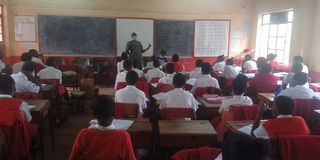Give all children their right to education

Mbaga Girls High School Form 3NE students in class on August 12, 2021.
Quality education is the hallmark of the global development agenda. The second of the Millennium Development Goals (MDGs) sought to achieve universal primary education while Sustainable Development Goals (SDGs) emphasise quality education as part of Resolution 70(i) of the UN General Assembly.
Recognising the pivotal role of teachers in the realisation of quality education, Unesco set October 5 as the World Teachers Day to celebrate tutors. The event recognises the invaluable contribution of teachers as facilitators of learning in schools. This year’s theme, “The right to education means the right to a qualified teacher”, underscored the notion that a qualified teacher is paramount for quality education.
In Kenya, teacher-related challenges continue to confront the education system despite efforts to recruit, motivate and train teachers. A Uwezo Kenya survey shows 22 percent of the parents polled ranked teacher shortage as a top challenge to making education accessible to all children.
The uneven distribution has continuously undermined learning outcomes in children. Besides, incessant insecurity in areas like northern Kenya has made the region to bear the brunt of teacher shortages for a long time.
The challenges teachers face, especially in far-flung areas, cast aspersions on the effectiveness and fairness of the school grading system by the Kenya National Examination Council (Knec). Is it fair, amid the glaring disparities? Can disadvantaged teachers and children in the North compete fairly with the rest? What is the panacea to the perennial teacher shortages and low teacher turnout in the marginalised areas?
The government has a responsibility, under Article 56(b) of the Constitution, to provide special education programmes for marginalised communities. The Ministry of Education, together with the National Council for Nomadic Education in Kenya (Naconek) recommends integrating madrasa into formal education. The North being predominantly Muslim, that would respond to its need for special education.
Enhanced hardship allowance and security in the region to enhance accessibility to education. An early warning system for impending attacks would secure teachers and students, attracting them to local schools.
Teacher training, development and deployment can ensure that children acquire quality education. Last year, the Teachers Service Commission introduced the School Improvement Programme initiative funded by Global Partnership for Education under the World Bank. It aims to train 90,000 primary school teachers to improve teaching and learning among pupils.
Infrastructural interventions in relation to health and hygiene for both teachers and students should be addressed. A Twaweza East Africa report shows a teacher-cash- on-pay system can motivate teachers and improve learning outcomes among students.
Lastly, equal distribution of teachers in schools will not only address teacher shortage but also fulfill the fourth goal of the SDGs that underscores inclusivity and quality education for all.
Aaron Kipngetich, Narok




